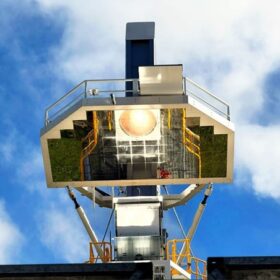CSIRO's Breakthrough in Solar-Powered Hydrogen Production
Key Ideas
- CSIRO researchers at the Newcastle Energy Centre have achieved a solar-to-hydrogen efficiency of over 20%, surpassing many existing systems by 5%.
- The breakthrough involves a beam-down solar reactor using concentrated solar power and doped ceria to produce green hydrogen, offering a reliable and cost-effective method without fossil fuels.
- The doped ceria technology, developed at Niigata University in Japan, is shown to produce over three times more hydrogen than traditional materials, showcasing the potential for future efficiency improvements.
- The innovation not only enhances hydrogen production but also opens doors for high-temperature reactions in various applications like metal refining, marking a significant advancement in Australia's solar thermal research capability.
Researchers at the Commonwealth Scientific and Industrial Research Organisation (CSIRO) in Australia have made significant advancements in solar-powered hydrogen production. Conducted at the Newcastle Energy Centre (NEC), the team has demonstrated a new full thermochemical hydrogen production cycle with a solar-to-hydrogen efficiency exceeding 20%, outperforming many existing systems by 5%. The breakthrough involves a beam-down solar reactor that utilizes concentrated solar power (CSP) and doped ceria to generate green hydrogen. This innovative approach aims to produce hydrogen in large volumes reliably and cost-effectively, without relying on fossil fuels unlike the conventional methods that lead to emissions.
The key element in this process is a metal oxide called doped ceria, a modified form of a naturally occurring mineral. When heated by solar energy, doped ceria releases oxygen atoms, which then absorb oxygen from water vapor when exposed to steam, resulting in the production of hydrogen gas. This hydrogen can be stored and used as fuel or in industrial processes, and the doped ceria material can be reused multiple times. Researchers from Niigata University in Japan, where the doped ceria was developed, have shown that this technology can produce over three times more hydrogen than standard materials used in similar reactions, indicating great potential for future efficiency enhancements.
The successful implementation of this technology not only revolutionizes hydrogen production but also opens up avenues for exploring high-temperature reactions in other applications such as metal refining. Dr. Noel Duffy, the Solar Technologies leader at CSIRO, highlighted the broader implications of this innovation for Australia's solar thermal research capability, emphasizing its versatility beyond hydrogen production. This breakthrough signifies a crucial step towards sustainable and efficient hydrogen production, contributing to the country's efforts in advancing renewable energy and fostering environmentally friendly practices.
Topics
South America
Renewable Energy
Green Technology
Energy Efficiency
Materials Science
Sustainable Development
Solar Energy
Scientific Advancements
Research & Innovation
Latest News
